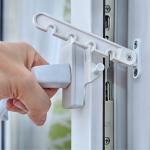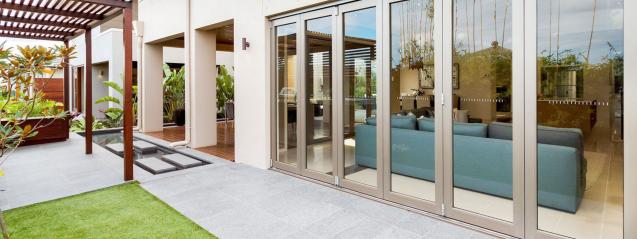
Window Restrictors: The Ultimate Guide
They are easy to install and can provide peace of mind for homeowners, landlords, and property managers. In this blog post, we will take a closer look at window restrictors, including their benefits, types, and installation methods.
Whether you're a homeowner looking to improve the safety of your home, or a property manager in charge of a multi-unit building, this guide will provide you with all the information you need to make an informed decision about window restrictors.
What Are Window Restrictors?
If you’re new to the concept of window restrictors, it’s important to learn the basics. These safety devices are installed in window frames to limit their opening distance. Styles may vary, but all offer sufficient ventilation and occupant safety.
How Do Window Restrictors Work?
Window restrictors are useful for a few reasons, most notably for child safety. Young children especially are at risk of falling over a window ledge, which could cause serious injury. To that end, window restrictors help keep children out of harm’s way by creating smaller window openings.
To a lesser extent, window restrictors help keep unwanted intruders out. It’s important to note that this security feature is limited by nature. Even a small window opening could become a point of entry under the right circumstances.
Types of Window Restrictors
Window restrictors are made to fit various types of windows. Here are some of the most common styles for each window type.
Concealed
A concealed window restrictor consists of a metal piece fitted to the interior window frame. The restrictor can be released to open the window fully by pressing a button. While it doesn’t require a key, it’s possible to fully open the window by accident.
Retrofitted
This type of window restrictor is made of a steel or cable part and can be locked or unlocked using a key. Keeping track of the key may prove difficult for some homeowners.
Sash
The sash of a window is the part that keeps the glass in place. In operable windows, it’s the part that is open or closed. Sash window restrictors are designed to limit how far the sash opens for added protection.
Otherwise known as sash stops, these window restrictors effectively function as locks. They are unlocked with a key for unrestricted access (i.e., full window opening). Homeowners are advised to limit the sash openings to 100 mm for optimal safety and ventilation.
Restrictor Cables
Much like chain locks on apartment doors, restrictor cables minimise window openings with a small window cable. The cable itself is attached to the static frame and window sash. This option may not be used to lock windows in a fully closed position. They’re relatively easy to install but require custom installation on metal or aluminium frames.
Restrictor cables are effective for child safety but ineffective for home security. Cables are relatively easy to cut or break, which could put your home at risk.
Snap Lock
Unlike other lock restrictors, this type does not require a key. It’s specifically designed for PVC window frames. The arm attached to the outside of the window connects to the block on the interior window frame. It is unlocked using a two-finger release. The extent of the window opening depends on its placement in the frame.
Sliding Lock
As the name suggests, a sliding lock is designed specifically for sliding windows. However, it functions as less of a lock than a stopper. The device itself is fitted onto the glass using a strong adhesive. This window restrictor is effective for child safety but insufficient for security purposes.
Lock Pins
Lock pins are an affordable window restrictor used on sliding windows. Unlike other options, homeowners can make their own by drilling a hole through the window frame and window. Next, a pin is inserted between both layers to keep the window in place. However simple, this solution does cause damage.
Folding Latches
This type of window restrictor is best for awning windows. The device includes a handle on the base frame that latches when the window is closed. If your child is tall enough to reach the latch, they may be able to undo it.
Restrictor Stays
These devices refer to a category of window restrictors attached to the window and frame. Once installed, the window cannot open wider than intended due to the permanent nature of the restrictor. If you’re looking for window restrictors for aluminium windows, this is a great pick.
Trickle Vents
These devices are not window restrictors, although they serve a similar purpose. Trickle vents allow for minimal ventilation without opening the window. They are also built to withstand the elements and prevent outdoor debris from entering the home.
The Installation Process
There are countless types of window restrictors for various window frames. Many of them can be installed using a handheld electric drill. Other types may require custom installation. Please check the specifications for each restrictor before beginning installation.
Other factors such as technical experience, building height or window frame material could impact feasibility. As with all home improvement projects, it’s best to err on the side of caution and ask for assistance as needed.
Other Safety Factors
Window restrictors are largely used to keep occupants safe. Here are a few things to consider before choosing and installing window restrictors.
- Do not use on windows designated as fire escapes
- Make sure all adults understand the proper use
- Choose a sensible place to store the keys for lock restrictors
- Limit window openings to 100 mm to keep children safe
- Consider applying to all windows above the ground floor
Practical Considerations
- Window restrictors are only effective if used and installed correctly
- Most window restrictors keep occupants safe
- Not all restrictors provide sufficient outdoor security
- An open window is an insecure window
- Certain windows may require more than one restrictor
Get Your Window Solution Sorted with Perth Window & Door Replacement
If you're in need of a quality window solution, Perth Window & Door Replacement Company can help keep your home in excellent condition. Their range of windows is second to none, boosted by quality customer service and a great installation process.
Ask us your latest home improvement questions or chat with our experts about all things windows by getting in touch with us today!



